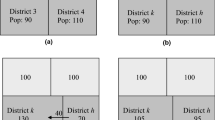Abstract
A successful political redistricting plan should be neutral by satisfying a number of requirements, such as equal population, and contiguity as well as compactness. Modeling approaches to solving this problem becomes either computationally intensive when the contiguity requirement is explicitly addressed, and requirements are used as more than one objective In this paper, a multiobjective mixed integer optimization model was developed based on developments in solving land acquisition problems. Using the approach, geographical criteria such as contiguity and compactness can be explicitly addressed. Tradeoff between compactness and equal population can be evaluated. The use of the approach based on synthetic data was demonstrated using a set of experiments.






Similar content being viewed by others
Notes
In computational complexity theory, the P problems are the problems solved in a polynomial time. The NP problems (non-deterministic polynomial time) are problems, which have no information whether or not problem is solved in polynomial time. NP-complete problem are the most difficult problems in NP problem and every problem in NP is reducible to it. NP-hard problems are the problems which are NP-complete and do not solved in a polynomial time.
References
Williams, J. J. C. (1995). Political redistricting: A review. Papers in Regional Science, 74(1), 13–40.
Norman, S. K., & Camm, J. D. (2003). The Kentucky redistricting problem: mixed-integer programming model. Working Paper.
Altman, M. (1997). Is automation the answer: The computational complexity of automated redistricting. Rutgers Computer and Law Technology Journal, 23(1), 81–142.
Altman, M. (1998). Modeling the effect of mandatory district compactness on partisan gerrymandering. Political Geography, 17(8), 989–1012.
Eagles, M., Katz, R. Z., & Mark, D. (2000). Controversies in political redistricting: GIS, geography, and society. Political Geography, 19(2), 135–139.
Wei, B. C., & Chai, W. Y. (2004). A multiobjective hybrid metaheuristic approach for GIS-based spatial zoning model. Journal of Mathematical Modeling and Algorithm, 3, 245–261.
Garfinkel, R. S., & Nemhauser, G. L. (1970). Optimal political districting by implicit enumeration techniques. Management Science, 16(8), B495–B508.
Shirabe, T. (2009). Districting modeling with exact contiguity constraints. Environment and Planning B: Planning and Design, 36, 1053–1066.
Steuer, R. E. (1986). Multiple criteria optimization: Theory, computation and application. New York: Wiley.
Williams, J. C., & ReVelle, C. S. (1996). A 0–1 programming approach to delineating protected reserves. Environment and Planning B, 23, 607–624.
Cohon, J. L. (1978). Multiobjective programming and planning. New York: Academic Press.
Choe, Byong Nam, Han, Seon Hee, & Jin, Heui Chae. (2014). Casual analysis on motivation and satisfaction of appling GIS for social-science research. Spatial Information Research, 22(6), 1–11.
Kim, B. (2015). A study on the implementation of microscopic traffic simulation model by using GIS. Spatial Information Research, 23(4), 79–89.
Lee, S.-Y., Jo, Hyun-Jae, Lee, Hyun-Ki, & Choi, Se-Hyu. (2015). Estimation of design wind speed for building using spatial information analysis. Journal of Spatial Information Society, 23(3), 79–89.
Sim, Gyoo Seong, Lee, Choon Ho, Lee, Tae Geun, & Jee, Gye Hwan. (2015). Development of strategics for establishment of spatial information by assessment of GIS-based flood risk. Journal of Korea Spatial Information Society, 23(2), 39–48.
Won, You Ho, Choi, Chang Gyu, & Lee, Joo Hyung. (2014). The influence factors analysis of the street revaitalization by spatial distribution of small retail businesses’ classification in Seoul City. Journal of Spatial Information Society, 22(6), 81–90.
Guo, J., Trinidad, G., & Smith, N. (2000). MOZART: A multi-objective zoning and aggregation tool. In Proceedings of the Phillippine computing science congress (PCSC).
Ricca, Federica, & Simeone, Bruno. (2007). Local search algorithms for political districting. European Journal of Operational Research, 189, 1409–1426.
Rincón-García, E. A., Gutiérrez-Andrade, M. A., de-los-Cobos-Silva, S. G., Lara-Velázquez, P., Ponsich, A. S., & Mora-Gutiérrez, R. A. (2013). A multiobjective algorithm for redistricting. Journal of Applied Research and Technology, 11(3), 324–330.
Duque, J. C., Anselin, L., & Rey, J. S. (2012). The max-p-regions problem. Journal of Regional Science, 52(3), 397–419.
Kim, Myung, & Xiao, N. (2017). Contiguity-based optimization models for political redistricting problems. International Journal of Applied Geospatial Research, 8(4), 1–18.
Grofman, B. (1985). Criteria for redistricting: A social science perspective. UCLA Law Review, 33, 77–184.
Mills, G. (1967). The determination of local government electoral boundaries. Operations Research Quarterly, 18, 243–255.
Mehrotra, A., Johnson, E. L., & Nemhauser, G. L. (1998). An optimization based heuristic for political districting. Management Science, 44(8), 1100–1114.
Kaiser, H. (1966). An objective method for establishing legislative districts. Midwest Journal of Political Science, 10, 200–213.
Nagel, S. S. (1965). Simplified bipartisan computer redistricting. Stanford Law Review, 17, 863–899.
Gearhart, B. C., & Liittschwager, J. M. (1969). Legislative districting by computer. Behavorial Science, 14, 404–417.
Harris, C. C., Jr. (1964). A scientific method of districting. Behavorial Science, 9, 219–225.
Liittschwager, J. M. (1973). The Iowa redistricting system. Annals of the New York Academy of Sciences, 219, 221–235.
Vickrey, W. (1961). On the prevention of gerrymandering. Political Science Quarterly, 76, 105–110.
Morrill, R. L. (1987). Redistricting, region, and representation. Political Geography, 6(3), 241–260.
Baker, G. E. (1990). The “totality of circumstances” approach. New York: Agathon Press.
Yong, H. P. (1988). Measuring the compactness of legislative districts. Legislative Studies Quarterly, 13, 105–115.
Weaver, J. B., & Hess, S. W. (1963). A procedure for nonpartisan districting: Development of computer techniques. The Yale Law Journal, 72, 288–308.
Bação, F., Lobo, V., & Painho, M. (2005). Applying genetic algorithms to zone design. Soft Computing—A Fusion of Foundations. Methodologies and Applications, 9(5), 341–348.
Keane, M. (1975). The size of the region-building problem. Environment and Planning A, 7, 575–577.
Skiena, S. (1990). Implementing discrete mathematics: Combinatorics and graph theory with mathematica. Boston: Addition-Wesley.
Author information
Authors and Affiliations
Corresponding author
Rights and permissions
About this article
Cite this article
Kim, M.J. Multiobjective spanning tree based optimization model to political redistricting. Spat. Inf. Res. 26, 317–325 (2018). https://doi.org/10.1007/s41324-018-0171-5
Received:
Revised:
Accepted:
Published:
Issue Date:
DOI: https://doi.org/10.1007/s41324-018-0171-5




